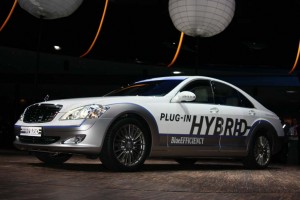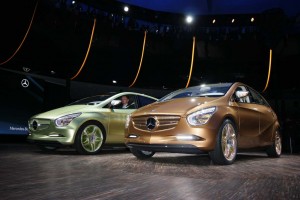
Look for a production version of the 2010 Mercedes-Benz Plug-in Hybrid Electric Vehicle, which will be based off the next-generation S-Class, according to Daimler CEO Dieter Zetsche.
It seems that everywhere you turn, at the 2009 Frankfurt Motor Show, automakers are plugging in, and Mercedes-Benz is no exception. Not to be outdone, the German luxury manufacturer is rolling out an assortment of plug-in hybrids, battery cars, fuel-cell vehicles and other high-mileage/low-emissions products and concept vehicles for the biennial event.
That’s a sharp turnaround for Daimler AG’s flagship brand which, for many years, resisted the idea of electrifying its products, fearing it would become increasingly difficult to differentiate them from the offerings of more mainstream brands. But a combination of shifting consumer attitudes and tougher government regulations has Mercedes making an aggressive bid to become one of the industry’s leaders in the shift to green technology.
“The electrification of the powertrain is key” to maintaining personal mobility, declared Dieter Zetsche, who serves double-duty as Daimler CEO and Mercedes’ brand boss.

Mercedes is also looking at opportunities for Plug-in Hybrid and Fuel Cell Vehicle technology, used in its prototypes, the E-Cell Plus and the F-Cell.
The automaker opened its news conference with the 2010 Mercedes-Benz S500 Plug-in Hybrid Electric Vehicle, or PHEV, concept vehicle. Despite its bulk, the prototype achieves the sort of fuel efficiency that would have been a challenge, not long ago, for even the most stripped-down diesel-powered minicars, burning just 3.2 liters of fuel for every 100 kilometers it travels. While that’s calculated on the European Union’s fuel economy test cycle, it would work out to roughly 70 mpg in the U.S.
The so-called “Blue Efficiency” sedan uses a compact, direct-injection V6 engine, noted Zetsche, mated to a hybrid-electric powertrain based around a Lithium-Ion battery pack. That allows the S500 to run for perhaps 20 miles on battery power alone.
While Mercedes officials wouldn’t discuss specific details, Zetsche hinted that a production version of the S500 PHEV “will be launched with the next-generation S-Class,” which could mean sometime during the first half of the coming decade.
Further from production were several other Mercedes prototypes, including the E-Cell Plus, a so-called Extended-Range Electric Vehicle. Like the S400 Blue Efficiency, the E-Cell Plus also combines a small internal combustion engine with a battery powertrain. But the battery pack is significantly bigger and, as with the planned Chevrolet Volt, the internal combustion engine never drives the wheels. It serves only as a generator to recharge the batteries when they run down.
The minicar uses an unusual design, placing the battery and electric drive components under the floorboards, providing more space for passengers and cargo than a conventional vehicle, with an internal combustion engine.
“I’m convinced this will win over even e-mobility skeptics,” asserted Mercedes’ technology chief, Thomas Weber.
Based on the subcompact B-Class Mercedes, another high-tech offering, dubbed the F-Cell, utilizes a fuel-cell, rather than batteries, though the current from the hydrogen-based powerplant drives the same sort of electric motor system found in the E-Cell Plus.
Advances in hydrogen storage and vehicle efficiency would allow the F-Cell to go for more than 250 miles on a tank of hydrogen, noted Weber.
In the long run, Mercedes hopes to produce “several 100 thousand” fuel cell vehicles, the tech czar declared, but he cautioned that before hydrogen vehicles – or battery cars – can jump into the mainstream, “a holistic approach is needed.”
That requires more than just the right cars from the auto industry. Like other carmakers, Mercedes is urging government leaders to step in to help set up the advanced energy infrastructures that will be needed, whether to produce hydrogen or to generate the electricity that would be needed by millions of new electric vehicles.
